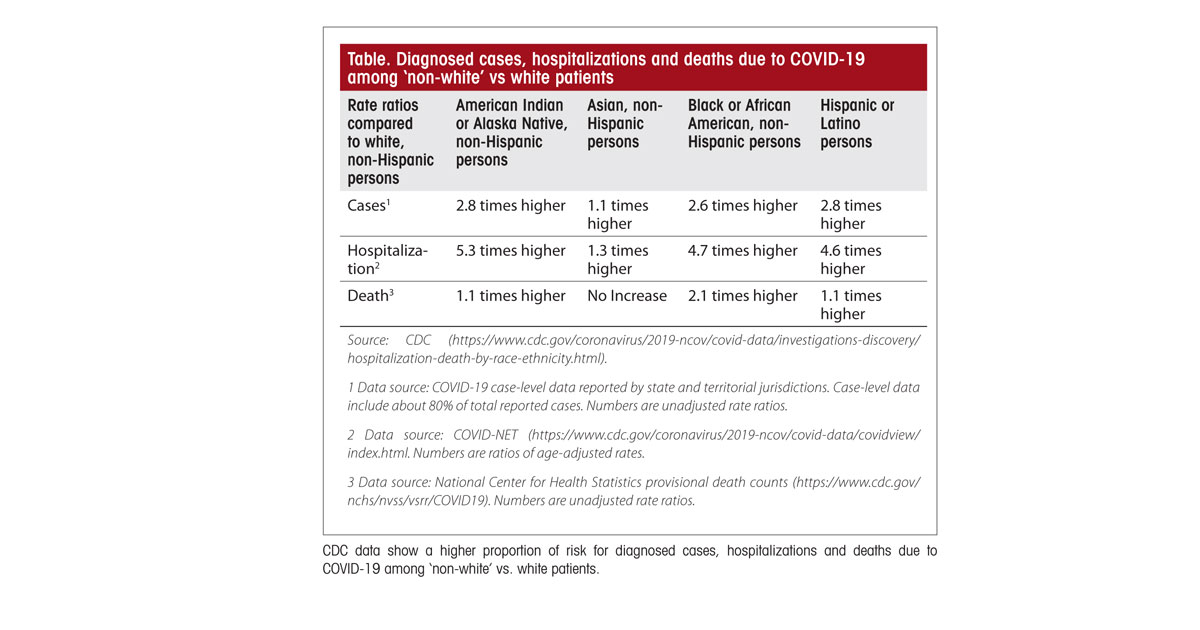Kidney community renews efforts to solve health disparities among people of color
According to the latest U.S. Renal Data System report, Black individuals are three times and Hispanic individuals are 1.8 times more likely to require renal replacement therapy vs. white patients.
Health disparities, linked to long-time structured racism in the United States, are the primary cause for that heightened risk for kidney failure among people of color, advocates in the kidney community told Nephrology News & Issues.
Deidra C. Crews, MD, ScM, FASN, FACP, said the problem goes beyond providing access to care.
“Access is necessary but is not sufficient for providing high-quality kidney care and mitigating racial inequities,” she told Nephrology News & Issues. “Simply being able to be seen by a nephrologist in a clinic, for example, does not mean that shared decision-making is being equitably engaged in and that referrals to treatments, such as transplantation, are being equitably made.”
Influence of structural racism
The challenge of providing equitable kidney care for all patients is not new, nephrologist Neil Powe, MD, wrote in an article published in 2008 entitled, “Let’s get serious about racial and ethnic disparities.”

“I am quite incensed by the lack of more rapid progress and outraged that we can’t cure these disparities,” Powe wrote. “We have talked and collected statistics about health disparities for decades. Why are disparities still with us? I believe this is because no one has been held accountable.”
Powe is now co-chair of a newly established National Kidney Foundation - American Society of Nephrology task force reassessing the inclusion of race in the estimation of GFR.
In recent testimony before the U.S. House Ways and Means Committee, ASN Policy and Advocacy Committee chair Michelle A. Josephson, MD, FASN, and committee member Mukta Baweja, MD, reminded legislators that little has changed from a decade earlier. “Sadly, kidney transplantation may be the clearest example of compounding and systemic racism in kidney health care,” they said. “ ... Black patients are less likely to be identified as transplant candidates, referred for evaluation to receive a transplant, and to complete the transplant evaluation. Black patients are also less likely to have the preferred living donor and less likely to be placed on the waiting list, while also being more likely to receive lower quality kidneys regardless of the age of the patient and length on the kidney waitlist ... [It is] a cyclical and compounding struggle that is nearly impossible to defeat without real identification and solution to racism.”
In a recent article in the Journal of the American Society of Nephrology, Crews and co-author Tanjala Purnell, MD, PhD, defined structural racism as the “mechanisms in which societies foster racial discrimination through systems of housing, education, employment, earnings, benefits, credit, media, health care, and criminal justice that reinforce discriminatory beliefs, values, and distribution of resources.”
One example of that, the authors wrote, is residential segregation, including the practice of redlining, in which mortgage lenders were instructed in the past to not make loans to people of color in certain geographic areas. “The effect of residential segregation on kidney health outcomes has been well documented,” Crews and Purnell wrote. “An analysis of United States patients initiating hemodialysis between 2000 and 2008 found that, among Black Americans exclusively, residence in highly racially segregated areas was associated with increased mortality.”
Access to care
While Medicare can level the playing field for patients diagnosed with end-stage renal disease – regardless of age, patients automatically are covered for dialysis and kidney transplant – access to specialists such as primary care physicians and nephrologists in chronic kidney disease stages 2 to 4 can be more difficult in urban areas that are disadvantaged.
“We have a set group of patients who have good access to care and primary care physicians refer them to us during early stages of CKD,” Paul W. Crawford, MD, a nephrologist with more than 40 years of practice in Chicago, told Nephrology News & Issues. He and his practice group attempt to manage between 4,000 to 5,000 patients in various stages of CKD; 85% to 90% are African Americans. “We get many patients who show up on the first day of dialysis who have had no previous care by a primary care physician. Access to a doctor for many of these patients does not exist,” he said.

Crawford blames the health care system that focus on fee-for-service care and pays little to slow progression of kidney disease. “It costs $85,000 a year to take care of a dialysis patient; pay me half of that to care for a CKD patient, and I will have an impact. But health insurance only pays for events and catastrophes,” Crawford said. “We still have a long way to go to help this population.”
Latinx patients face the same challenges in gaining access to care, Denver internist Lilia Cervantes, MD, told Nephrology News & Issues. “A recent study by Vart [and colleagues] demonstrates that while the prevalence of CKD has remained stable in other ethnic groups in the last 2 decades, the prevalence rate has nearly doubled in Mexican American population. The reasons are complex and multifactorial because there are several social challenges faced by the Latinx community,” she said. “In that particular article by Vart [and colleagues], there were also higher rates of CKD prevalence among groups with lower education attainment and income.”
The Latinx community faces several access to care issues, Cervantes said. “They remain one of the highest uninsured communities in the country. This is important because for Latino patients, diabetes is the leading cause of end-stage kidney disease. Diabetic kidney disease can be slowed with lifestyle changes, better control of diabetes, and certain medications,” Cervantes said. “Yet, Latinos are less likely to have their diabetes under control, to be on medications that slow the progression of kidney disease, and to be aware of their kidney disease.”
Other factors that lead to inadequate care include low trust, provider bias, communication barriers because of the lack of language interpreters in the medical setting, and cultural differences, Cervantes said. ”We must act now and consider community-based interventions to eliminate structural inequities that improve kidney disease outcomes in racial/ethnic minority groups.”
One way to address disparities faced by the Latinx community is through the use of community health workers, Cervantes said. “Community health workers can provide kidney-disease prevention education, conduct screening tests, encourage adherence to medications and refer to health care providers. Oftentimes, the community health workers are employed by community-based organizations that are trusted by the community and that also provide resources for social challenges faced by the community. This type of partnership between health care systems and community-based organizations could be helpful to reducing disparities.”
COVID-19
Many have pointed to the disproportionately higher rate of diagnosed cases, hospitalizations and deaths from COVID-19 among Black, Hispanic, Asian and American Indian patients compared with white patients as an indication of health disparities (see Table).
In its research, the CDC links the data to social determinants of health; specifically, there is a higher risk for COVID-19 due to discrimination in systems meant to protect well-being or health.
“Discrimination, which includes racism, can lead to chronic and toxic stress and shapes social and economic factors that put some people from racial and ethnic minority groups at increased risk for COVID-19,” the CDC said.
ASN, NKF organize work groups
The NKF-ASN taskforce co-chaired by Powe is looking at the inclusion of race in the estimation of GFR and its implications for the diagnosis and management of patients with or at risk for kidney disease.

“Several equations have been developed to estimate kidney function from serum creatinine concentration, adjusting for demographic factors including age, sex, race and/or body weight based on correlations with measured GFR across diverse populations,” according to an NKF-ASN taskforce statement. “However, unlike age, sex and body weight, race is a social, not a biological construct. Including adjustment for race in these eGFR equations ignores the substantial diversity within self-identified Black or African American patients and other racial or ethnic minority groups.”
The task force is expected to issue its initial recommendations later this year.
ASN has also formed a diversity and inclusion committee which is developing an online curriculum on how nephrologists and other kidney health professionals can be anti-racist, and is focusing more of ASN’s efforts on addressing issues related to graduates of international medical schools, visas, immigration and segregation, which includes NIH rules around eligibility for grant funding. The committee encourages nephrology fellowship-training programs to consider diversity, equity and inclusion when promoting training program directors, associate training program directors and key clinical faculty.
With the renewed focus on addressing discrimination, Crews and Cervantes believe the time is right to bring about change.
“We can each play a role in turning this around by examining our own individual nexus of influence and leveraging our platforms. These paths are by no means inevitable,” Crews said.
“To fix disparities long-term, we have to eliminate structural inequities,” Cervantes added. “Access to care for all, regardless of immigration status, insurance status or existing comorbidities, is one of many steps we can take.”
- References:
- Crews D, et al.JASN.2020;doi10.1681/ASN.2020060809.
- https://jamanetwork.com/journals/jamanetworkopen/fullarticle/2768339
- Li J, et al. JAMA Open Netw.2020;doi10.1001/ jamanetworkopen.2020.15470.
- Powe N. J Am Soc Nephrol. 2008.doi:10.1681/ASN.2008040358
- www.asn-online.org/news/item.aspx?ID=173
- www.cdc.gov/coronavirus/2019-ncov/community/health-equity/race-ethnicity.html
- www.kidney.org/news/establishing-task-force-to-reassess-inclusion-race-diagnosing-kidney-diseases
- United States Renal Data System. 2019 annual data report: Epidemiology of kidney disease in the United States. NIH, National Institute of Diabetes and Digestive and Kidney Diseases, Bethesda, Md.
- For more information:
- Lilia Cervantes, MD, is an associate professor of medicine at the University of Colorado School of Medicine and can be reached at lilia.cervantes@dhha.org.
- Paul W. Crawford, MD, is with Associates in Nephrology SC in Chicago and can be reached at paul.crawford@ainmd.com.
- Deidra C. Crews, MD, ScM, FASN, FACP, is an associate professor of medicine in the division of nephrology and associate director for research development at Johns Hopkins Center for Health Equity in Baltimore and can be reached at dcrews1@jhmi.edu.
